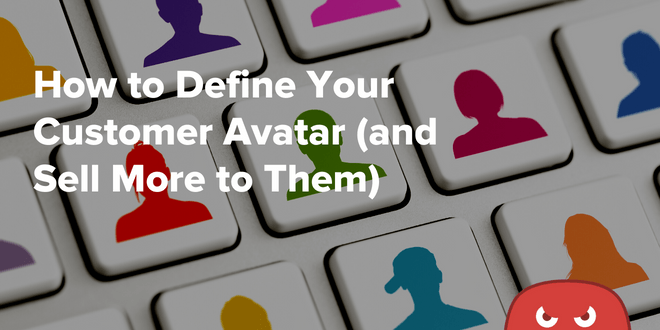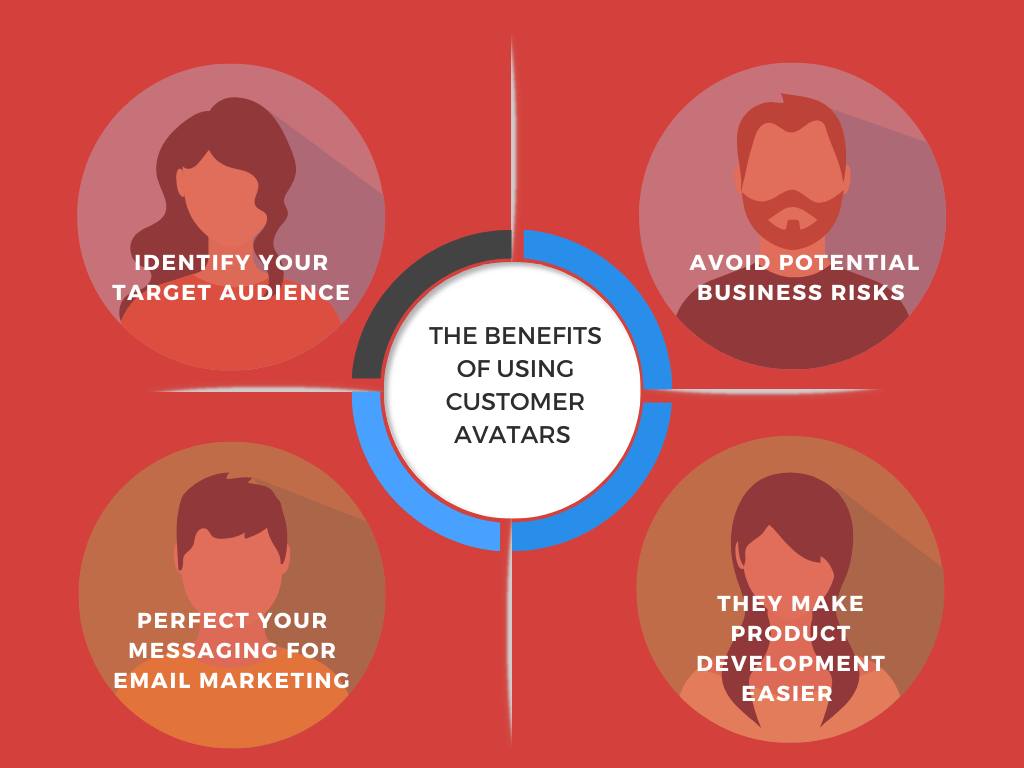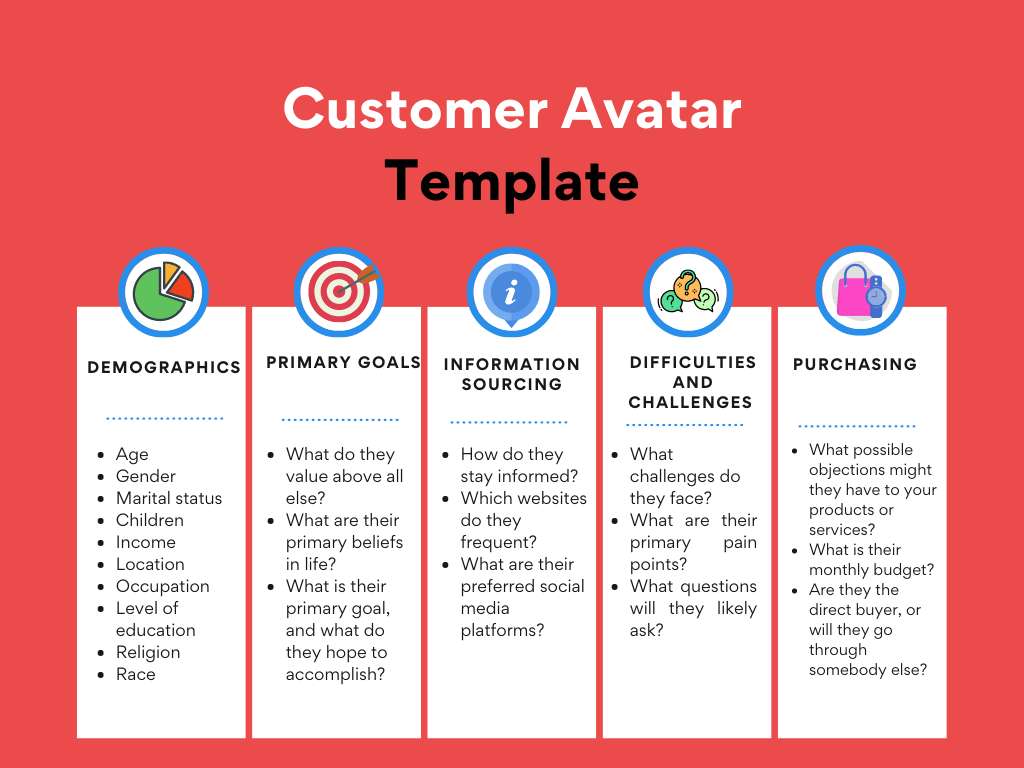Quick Links
What does your ideal client or customer look like?
By that, we don’t mean a generalized version of all your existing customers.
Instead, we’re talking about a fictionalized buyer persona that has a name, picture, personality, common pain points, and even marital status.
If that sounds more along the lines of writing a fictional novel than a marketing strategy, you wouldn’t be 100% wrong. Yet, creating an ideal customer avatar is a tried and true marketing effort that produces actual results – which is why companies of all sizes create detailed customer profiles.
The proof?
93% of companies that were able to exceed lead and revenue goals all had one thing in common – they segmented their databases according to buyer personas.
Also, Hubspot found that the use of marketing personas made websites 2 – 5 times more effective and easier to use by their target audience.
These stats reinforce the effectiveness of creating a fictionalized perfect customer avatar for your business. With only a basic marketing persona (created by analyzing demographics only), you’re leaving a lot on the table – which can lead to incorrect assumptions and false categorizations.
That’s why we’ve put together this guide for fleshing out your ideal customer persona – complete with a customer avatar template you can use.
Read on to learn how you can create a client avatar for your business or organization.
What are Customer Avatars Anyway?
First, it’s crucial to clear up the confusion surrounding the terminology, as customer avatars can go by several different names (as you may have discovered in the intro).
Customer avatars are also called:
- Buyer personas
- Customer persona
- Marketing persona
- Target market
- Target audience
All these terms can refer to customer avatars, but they can also refer to more general marketing personas, hence the confusion.
However, here is the true definition of a customer avatar:
A customer avatar is a detailed profile of your perfect potential customer. It focuses on a single, fictional person instead of categorizing people into generalized groups. As a result, no assumptions are made about the person, and the avatar outlines every detail about them, which provides marketers with a myriad of targeting tools.
So if you see the term ‘buyer persona‘ referring to a specific person representing a potential customer, that’s a customer avatar. Yet, if the buyer persona is used to represent general demographics, it’s not a true customer avatar.
Also, many businesses and organizations utilize more than one customer avatar, so it’s crucial not to limit yourself to just one if you market to a broad audience.
A customer avatar is a great way to avoid trying to market your products and services to everyone, which is always a mistake. With an avatar, you’ll get to know your typical audience member on a personal level, which is highly valuable for your marketing campaigns.
Does Your Company Need a Customer Avatar?
Some business owners will question if they need to create a customer avatar or not. After all, if you’re already studying your target audience‘s demographics and buying habits, what’s the point?
Let’s put this issue to bed right now – every organization (even nonprofits) can benefit significantly from creating customer avatars.
Why is that?
It’s because having a detailed understanding of your typical customer is ALWAYS a good thing, no matter your industry. If you understand your audience on a deeply personal level, it will benefit every aspect of your operation.
It’ll also help you avoid wasting time and valuable resources on losing endeavors. For instance, if you don’t know what your customers truly want, you’ll have a hard time creating content and developing new products.
Creating customer avatars is even more crucial for startups and small businesses, as they will help you make the most out of your budget. Doing the research involved with creating an avatar will also inform you how much you need to segment your market (i.e., how many customer avatars you need to create).
Building a customer avatar isn’t a one-off task, either.
Companies that find the most success with their avatars understand that a customer’s wants, desires, problems, and hangouts all change over time – hence the need to update your avatars periodically.
Even churches and charitable organizations benefit from creating avatars, which is why they build donor avatars.
It shows that developing an intimate understanding of a target market is always a good idea, no matter the industry or type of business.
What are negative customer avatars?
Besides avatars that represent ideal potential customers, some companies also opt to create negative customer avatars.
What are those?
A negative customer avatar represents the type of customer that you DON’T want. Believe it or not, this is also a beneficial practice that any company or business can employ.
To start developing a negative customer avatar, think of all the nightmare customers you’ve dealt with in the past and make a list of their traits.
What were they most disappointed with by your products or services? What traits did they have in common? (i.e., argumentative, difficult to please, trying to take advantage of the system, etc.)
Not only will this help you discover which types of consumers to avoid with your business strategy, but it can also help you identify areas in your business that you can improve.
For instance, you may uncover that you need to improve your customer service by analyzing negative customer experiences with your brand.
An additional benefit is that negative customer avatars can help you avoid spending time and resources on a market segment that has no interest in your products or services. Without taking the time to analyze your audience in this way, you might continue to waste money targeting the wrong customers.
Certain types of customers won’t be a good fit for your products or services for reasons besides personal ones, too.
It could be that a prospect is too technically advanced for what you sell or that certain prospects only use your content to conduct their own research.
The Benefits of Using Customer Avatars
If you’re still on the fence about developing customer avatars for your digital marketing strategy, it might be because you’ve yet to see what it will provide for you.
After all, creating customer avatars will take effort from your staff, which can be quite an investment if your employees are notoriously pressed for time.
The good news is all that market research won’t be for naught.
Instead, the little amount of money you spend developing customer avatars pales in comparison to what you stand to gain from incorporating them.
Still don’t believe us?
Then check out these numerous benefits your organization will see from defining customer avatars.
Identify your target audience
No business will get very far without a specific target audience in mind, as few products and services are universal.
If your idea is to market your business to absolutely everyone, you’ll likely wind up wasting all your money with little to show for it, which is never a desirable outcome.
While it’s commonplace for companies to study demographic information and customer buying habits to learn more about their audience, creating a customer avatar takes this research to the next level.
You’ll be able to truly get inside the mind of one of your customers, which will help you develop the perfect messaging for them. That’s the best way to relate to an audience, build a following, and boost your conversion rates.
With a detailed customer avatar, you avoid speaking to the wrong people in your ads and content, which will help you squeeze the most out of every penny of your budget. Even with a well-defined niche to focus on, you’re likely still wasting money by not having a customer avatar to go along with it.
Avatars will help you penetrate further into your niche so you can solve your audience’s pain points, answer their questions, and speak their language to win them over.
According to ITSMA, buyers are 48% more likely to go with solution providers if they personalize their marketing to address their personal issues, and developing a customer avatar is the best way to do so.
Avoid potential business risks
A customer avatar helps you keep your eye on the goal when crafting ads, articles, and blogs for your company.
Without one, your content likely won’t scratch your potential customers‘ itch. Instead, you may end up focusing on the needs of prospects that aren’t the best fit for your company but only seem like it at the time.
What do we mean by that?
Let’s consider an example. Say that you sell parts for classic cars online but don’t have a customer avatar. A few well-meaning customers asked if you could provide more modern parts instead. Eager for the business, you accommodate them and start carrying modern parts, which in turn alienates your true fans (classic car enthusiasts) – causing a steep drop-off in revenue.
Having a detailed and well-defined customer avatar for your business would have helped you avoid this issue entirely.
Perfect your messaging for email marketing
With a customer avatar, it becomes far easier to write emails directly to your target audience. You’ll know what type of language to use, which will make it feel as if they’re reading an email from a friend.
In addition, you’ll have an intimate understanding of their primary problems and questions, which will make your emails far more effective.
Writing convincing calls-to-action (CTAs) will also become easier to boost your conversion rates.
Last but not least, your customer avatars will let you know if you need to segment your email marketing campaigns. For instance, if you have three customer avatars, you should create an email marketing campaign for each one.
They make product development easier
Since you’ll know your customers on a near-personal level, knowing which new products and services they’ll go for will become far easier.
Once again, this will help save your company a ton of money.
If you build a new product that doesn’t interest your audience or solve one of their problems, don’t expect it to sell very well. That’s why it’s so imperative to use customer avatars to inform product development decisions.
Defining a Customer Avatar for Your Business
Now that you know why customer avatars are so crucial, it’s time to learn how to create one for your organization.
Building a customer avatar will take a lot of time and effort, and you shouldn’t base anything on guesses.
Instead, you’ll need to base everything on accurate data and in-depth market research.
The good news?
This guide contains everything you need in order to build a customer avatar from scratch, so let’s get started.
Step #1: Pick a name and choose a picture
The first step is to give your customer avatar a name, but it shouldn’t be any old name (i.e., Jim is too vague).
Rather, the name should include some specific information about who they are. An example will be naming your avatar CEO Jim if your products target business executives.
It’s imperative to think about who your potential customers are during this step to come up with the best name possible. Say your niche is health and wellness, and you’re targeting fitness enthusiasts. In this case, you could name your avatar something like Fitness Fred.
If your audience is segmented into a few groups, you’ll need to come up with avatars for each one, which means coming up with more names.
You should also choose a photo, as it helps to visualize what your avatar looks like. For this, try to imagine one of your most loyal customers. Someone who regularly buys your products and doesn’t hesitate to leave glowing reviews.
What do they look like?
You can even go so far as to use their social media profile picture as your avatar photo. While it may seem tempting to skip this step, putting a face to the name will help you humanize your avatar. That comes in handy whenever you sit down to create content, as you can picture that you’re writing directly to your avatar.
Step #2: Define their demographics and psychographics
Next, you need to analyze your existing customers, paying close attention to their demographics and psychographics.
Demographics will help you identify who your customers are, and psychographics will help you uncover why they buy your products.
For your demographic information, analyze your customers based on the following:
- Age
- Gender
- Income
- Marital status
- Kids
- Habits
- Hobbies
- Job-status
- Religion
- Race
Psychographics include what your audience believes, enjoys, and values. While demographic information tends to be readily available, psychographic information is a bit more tricky to uncover.
Ways to uncover psychographic data include:
- Create polls on Facebook and Instagram asking your audience what they enjoy and value.
- Conduct former client/customer interviews to get a glimpse into how they think.
- Start a focus group or gather data from an existing one.
- Investigate your website analytics to uncover customer preferences and buying habits.
These are all ways you can generate a psychographic database if you don’t have one already.
Step #3: Identify their primary goals
Next, what does your avatar hope to achieve in life? What is their ultimate goal, and how can your products and services bring them closer to that?
For instance, if your audience consists of entrepreneurs, their goals are likely to be something along the lines of:
- Earning enough revenue to quit their day job
- Finding independence and freedom
- Setting their own work hours
- Discovering ways to earn passive income
Just like that, you have a series of goals that can influence your content, products, and services.
Step #4: Uncover your avatar’s backstory
Where did your customer avatar come from? Did they spend a lot of time working jobs they hated before finding their calling? Do they come from cities or small towns?
These are helpful questions to ask yourself, as they’ll help you further understand your customer avatar and the decisions they’re likely to make.
Understanding their background will also help you gain insight into your avatar’s mindset and what you can do to satisfy their needs.
Step #5: Fill out a customer avatar template
Last but not least, here’s a free worksheet you can fill out to define your customer avatar:
Demographics
- Age:
- Gender:
- Marital status:
- Children:
- Income:
- Location:
- Occupation:
- Level of education:
- Religion:
- Race:
Primary goals
- What do they value above all else?
- What are their primary beliefs in life?
- What is their primary goal, and what do they hope to accomplish?
Information sourcing
- How do they stay informed?
- Which websites do they frequent?
- What are their preferred social media platforms?
Difficulties and challenges
- What challenges do they face?
- What are their primary pain points?
- What questions will they likely ask?
Purchasing
- What possible objections might they have to your products or services?
- What is their monthly budget?
- Are they the direct buyer, or will they go through somebody else?
Once this template is complete, you’ll have a fully-defined customer avatar or avatars ready for immediate use.
Final Takeaways: Defining Your Customer Avatar
That’s what it takes to define a customer avatar that’s detailed enough to provide excellent results. By creating a customer avatar, you’ll gain invaluable insights into your target audience that you wouldn’t have found otherwise.
That’s why creating avatars is a revered marketing technique practiced by organizations of all types and sizes.
If your business has hit a snag, defining a customer avatar may be just what you need to snap out of it.
Do you need help formulating a marketing campaign for your business?
If so, don’t wait to reach out to us at HOTH X, our fully managed SEO services. Our experts will handle every aspect of your digital marketing strategy, including defining your unique customer avatar, so don’t wait to book a call today.











